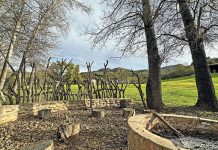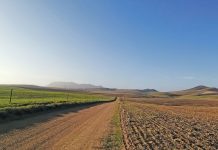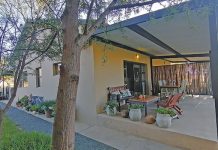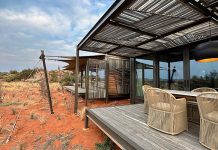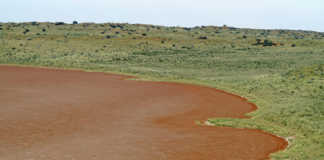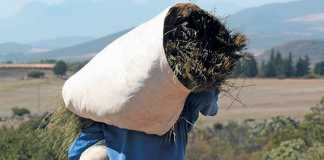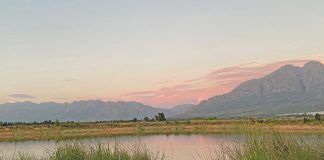I leant away from my laptop and pressed my fingers to my screen-weary eyes. When I opened them again, a flash of bronze-green caught my eyes.
Resting my elbows on the desk, I watched as a tacazze sunbird (Nectarinia tacazze) landed on a shrub in the garden outside my office.
Turning upside down and using its long tail for balance, it sipped nectar from an orange-coloured flower and, a split second later, flitted onto the next bloom. The paler, nondescript female landed below him.
He chirruped excitedly and flew to another stalk. With partly open wings quivering, he bowed in an elaborate courtship display. Another sunbird alighted on a stalk nearby.
It was an amethyst sunbird male (known as black sunbird in SA) with a short tail and black plumage less flamboyant than that of the tacazze sunbird. That is, until the sun catches it. An iridescent rosy purple glints on its chin while the top of its head is bright metallic green.
Sunbird males are very territorial and aggressive towards others of their own species, as well as other species. The tacazze sunbird swoops down on the intruder, chasing him off. The darting, dipping and characteristic high-pitched calls draw the attention of other birds and soon there’s a bird party in my garden.
Easily distracted
My intentions of finishing my article evaporated. Instead I grabbed my camera and crept onto the veranda to record the avian merrymaking.
As SA expats, my husband and I have lived in several countries on the African continent, none as diverse and beautiful as Kenya, our present country of residence. My husband had accepted an appointment on a mine in a remote area within the Great Rift Valley.
Our house and garden is set in a corner at the edge of the grassland surrounding the valley, with dense African bush on three sides and tangled undergrowth sprawling over the wooden boundary fence. Within the grounds we have an acacia tree, several euphorbias, a giant baobab and a forest of other indigenous trees.
At the top of the garden is a giant rubber tree. The roots periodically cause havoc with our French drain system, but it is home to a family of tree squirrels and at night bush babies, and a resident owl often calls from there.
Various fruit trees and numerous small introduced trees and shrubs add variety. As a keen gardener and avid birdwatcher, I’ve combined these passions. I enjoy the outdoors while gardening with primarily natural indigenous vegetation to attract birds and other wildlife.
Within the first couple of months, I discovered a valley teeming with birds. A few species were familiar to me, but most were first-time sightings.
Before my initial sighting of Ross’s turaco and the white-crested turaco, I heard their calls. The latter utters a long, hooted ‘aaaah’ followed by 10 to 20 raucous barks sounding, to me, like chain-smoking Chihuahuas. Through stealth and patience I eventually spotted them.
Dozens of birds, hitherto unknown to me, visit our garden: Kingfishers, bee-eaters, barbets, parrots, puffbacks, orioles, and several robin-chat species. No fewer than five hornbill species, including large and graceful black-and-white-casqued hornbills, make short stopovers in our patch of green.
Keep what they like
And we have sunbirds – many sunbirds – a topic that brings me back to the point of my story. Regular visitors to our garden include these sunbirds: tacazze, bronzy, amethyst, Hunter’s, scarlet-chested, variable and the so-called beautiful sunbird.
Shortly after I started converting the garden to a more water-friendly, low-maintenance, natural haven for birds, I saw a familiar-looking plant on the side of the road while travelling out of the valley. It looked like lion’s ear (Leonotis leonurus), a shrub I have in my South African garden.
The next day the gardener, Stanley, armed with a shovel, and I with my camera, walked up the mountain road. Near a marshy area below the camp reservoir where we’d previously found papyrus and setaria, (a grass that draws flocks of seed-eaters to my garden) we found a large clump of lion’s ear. We took five plants and left the others intact where they continue to thrive.
After a bit of research, I discovered that these shrubs were in fact lion’s tail (Leonotis nepetifolia). Also known as Christmas candlestick, this plant is indigenous to Africa.
Introduced widely, including southern India, it is listed as an invasive garden plant in Australia and a pest plant in Hawaii. Although the taxonomy of the genus is at present a nightmare, most other recognised species in this genus are also indigenous to Southern Africa.
Growing to almost 3m tall, L. nepetifolia has whorls of striking, lipped orange flowers. The soft serrated leaves resemble those of the perennial catnip (Nepeta cataria), and can grow up to 10cm wide. In a few weeks, as an annual, L. nepetifolia will die down to reappear next autumn.
The sunbirds won’t miss a beat as they move to the evergreen sleeping hibiscus (Malvaviscus penduliflorus), introduced shrubs that flower profusely in my garden. Which poses the question: should I only plant indigenous species in my garden or do exotic species also have their place?
My theory, one which works well, is that I put in indigenous plants if they suit the area. It’s no use planting indigenous coastal plants in Free State and vice versa. They die! I also don’t frenetically pull up and throw out exotic shrubs and trees. If they’re waterwise, disease-free and non-invasive, they’re allowed to stay. These well-behaved exotics attract a wide variety of butterflies, pollinators and birds.
Conservation and sustainability of the world’s precious and dwindling resources should be important to us.
I believe in working with nature instead of against it. The plethora of sunbirds, other birds and insects in my garden is testimony to this. How about you?
For more information on this article contact Abré J Steyn on 083 253 4822 or email [email protected].


